Compiled Quotes/Links/Explanations - the GODZILLA Cards

IKORIA: Every Godzilla Reference, with the Corresponding Card, and the Monsters' Backstories
By CaptainJamoke, April 15, 2020 at 11:00 PM EST
THIS COMPILATION OF INFORMATION IS DESIGNED FOR YOUR EASY FUTURE REFERENCE, AND WILL SAVE YOU TIME IN OBTAINING INFORMATION RELATED THERETO. I INTEND FOR THIS ARTICLE TO BE USEFUL TO ANYONE LOOKING TO DESIGN A DECK BASED ON A GODZILLA THEME.
Per Wizards of the Coast Employee, Mike Turian (Principal Product Designer), “As we worked on Ikoria: Lair of Behemoths, we knew we had an amazing opportunity to tap into the cultural phenomenon of Godzilla. Magic was finally going to a world filled with its most epic monsters, so it was too good of an opportunity to miss partnering with the Toho Corporation and its iconic monsters such as Godzilla, Mothra, and King Ghidorah. We call these cards Godzilla Series Monster cards. For each Godzilla Series Monster, we went through Ikoria and found the best flavor fit and gave each Godzilla Series Monster card its own card in the set. A total of 19 cards were given this treatment. One card, the Buy-a-Box card, only exists in its Godzilla Series form, but each of the others has both an Ikoria card and a matching Godzilla Series card. For the purposes of playing, they are equivalent to one another (that is, you can still only play a maximum of 4 copies in a deck no matter if you are playing the Godzilla Series or Ikoria versions).” Source.
MTGA-FRIENDLY TEXT LIST (CAN BE COPIED DIRECTLY INTO GAME CLIENT, FROM HERE USING "IMPORT"):
1 Huntmaster Liger (IKO) 16
1 Yidaro, Wandering Monster (IKO) 141
1 Gyruda, Doom of Depths (IKO) 221
1 Illuna, Apex of Wishes (IKO) 190
1 Brokkos, Apex of Forever (IKO) 179
1 Nethroi, Apex of Death (IKO) 197
1 Luminous Broodmoth (IKO) 21
1 Snapdax, Apex of the Hunt (IKO) 209
1 Titanoth Rex (IKO) 174
1 Everquill Phoenix (IKO) 114
1 Dirge Bat (IKO) 84
1 Gemrazer (IKO) 155
1 Vadrok, Apex of Thunder (IKO) 214
1 Crystalline Giant (IKO) 234
1 Sprite Dragon (IKO) 211
1 Pollywog Symbiote (IKO) 63
1 Mysterious Egg (IKO) 3
1 Void Beckoner (IKO) 104
Decklists featuring these cards (more to be added):
SHIN GODZILLA (2016), THE DECK
Featuring Yidaro, Wandering Monster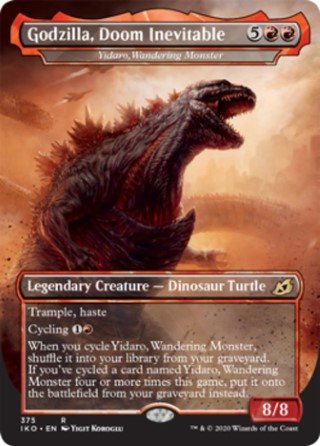 a/k/a Godzilla, Doom Inevitable and inspired 2016's Shin Godzilla. This is a Red, White, and Blue cycling deck reminscent of the "Astral Slide" cycling archetype from ways back.
a/k/a Godzilla, Doom Inevitable and inspired 2016's Shin Godzilla. This is a Red, White, and Blue cycling deck reminscent of the "Astral Slide" cycling archetype from ways back.
USEFUL REFERENCE INFORMATION FOR EACH OF THE GODZILLA MONSTERS IN IKORIA:

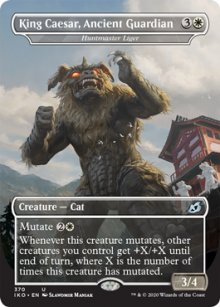
Huntmaster Liger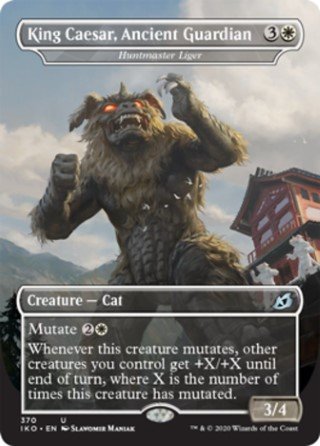 & King Caesar, Ancient Guardian
& King Caesar, Ancient Guardian
“King Caesar is a kaiju who first appeared in Toho's 1974 film Godzilla vs. Mechagodzilla. In his first film appearance, King Caesar is portrayed as a guardian deity and the protector of an ancient Japanese family. Awakened from a dormant state, King Caesar joins forces with Godzilla to vanquish Mechagodzilla.” Wikipedia Link
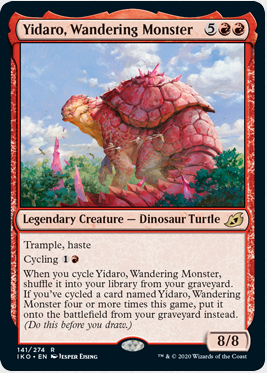
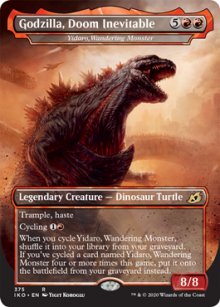
Yidaro, Wandering Monster & Godzilla, Doom Inevitable
& Godzilla, Doom Inevitable
“Godzilla (Japanese: ゴジラ, Hepburn: Gōjira) is a fictional monster, or kaiju, originating from a series of Japanese films of the same name. The character first appeared in Ishirō Honda's 1954 film Godzilla and became a worldwide pop culture icon, appearing in various media, including 32 films produced by Toho, three Hollywood films and numerous video games, novels, comic books and television shows. Godzilla has been dubbed the King of the Monsters, a phrase first used in Godzilla, King of the Monsters!, the Americanized version of the original film.” Wikipedia Link

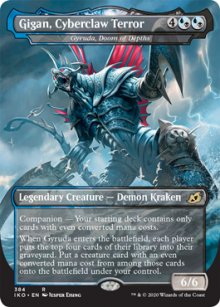
Gyruda, Doom of Depths & Gigan, Cyberclaw Terror
& Gigan, Cyberclaw Terror
“Gigan is a kaiju from Toho's Godzilla and Zone Fighter franchises who first appeared in Godzilla vs. Gigan. Gigan is a cyborg space monster sporting a huge buzzsaw in its frontal abdominal region and large metallic hooks for hands. Gigan is considered one of Godzilla's most brutal and violent opponents, and the first kaiju in the Toho sci-fi series to make him bleed. WatchMojo.com listed Gigan as #4 on their ‘Top 10 Godzilla Villains’ list, while Complex listed the character as #2 on its ‘The 15 Most Badass Kaiju Monsters of All Time’ list.” Wikipedia Link
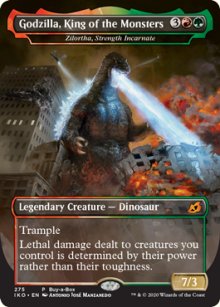
Zilortha, Strength Incarnate (Godzilla, King of the Monsters)
(Godzilla, King of the Monsters)
“Following an American hydrogen bomb test in the Pacific Ocean, a giant prehistoric reptile was disturbed from its underwater slumber and heavily irradiated. The monster began attacking various ships in the waters off Japan, prompting a search party to be sent to Odo Island, where some of the survivors had washed ashore. The islanders believed the shipwrecks were caused by Godzilla, a giant sea monster from their folklore which they believed would come ashore to feed on humanity. One night, a typhoon struck the island, leaving it devastated. However, it was apparent most of the damage was caused by something other than a typhoon, as houses in the village appeared to have been crushed from above. A research team headed by Kyohei Yamane was sent to the island, and discovered a giant radioactive footprint on the island, with a Trilobite embedded in it. Suddenly, the monster that was responsible for the shipwrecks and the damage on the island appeared over a hill on the island. The people fled, realizing the creature was 50 meters in height.” Godzilla Fandom Link

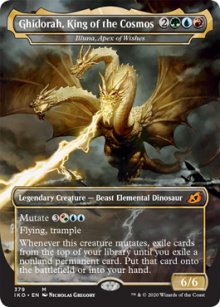
Illuna, Apex of Wishes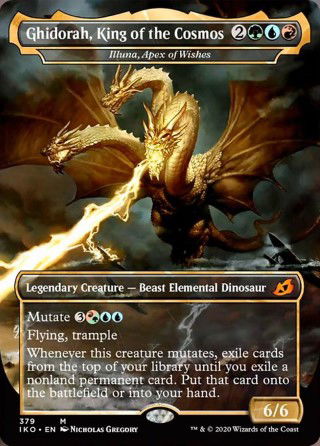 & Ghidorah, King of the Cosmos
& Ghidorah, King of the Cosmos
King Ghidorah, “first appeared in Ishirō Honda's 1964 film Ghidorah, the Three-Headed Monster. Although the name of the character is officially trademarked by Toho as ‘King Ghidorah’, the character was originally referred to as Ghidorah or Ghidrah in some English markets.
Although King Ghidorah's design has remained largely consistent throughout its appearances (an armless, bipedal, golden-scaled, bat-winged dragon with three heads and two tails), its origin story has varied from being an extraterrestrial planet-killing dragon, a genetically engineered monster from the future, a guardian monster of ancient Japan or a god from another dimension. The character is usually portrayed as an archenemy of Godzilla and a foe of Mothra, though it has had one appearance as an ally of the latter.
Despite rumors that Ghidorah was meant to represent the threat posed by China, which had at the time of the character's creation just developed nuclear weapons, director Ishirō Honda denied the connection and stated that Ghidorah was simply a modern take on the dragon Yamata no Orochi.” Wikipedia Link
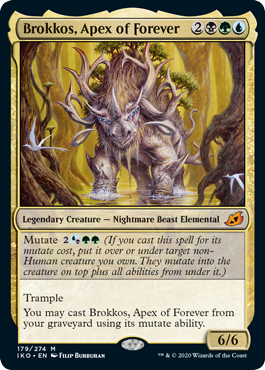

Brokkos, Apex of Forever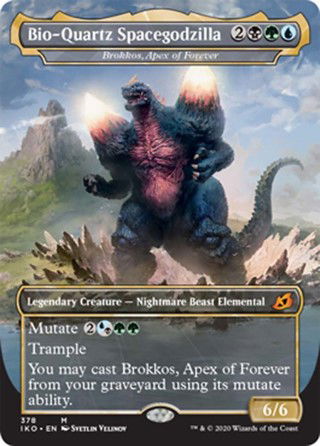 & Bio-Quartz Spacegozilla
& Bio-Quartz Spacegozilla
SpaceGodzilla first appeared in Toho's 1994 film Godzilla vs. SpaceGodzilla, and, “The character was designed as a homage to the monster's hinted progenitor Biollante by incorporating tusks and a hissing roar reminiscent of the latter monster. Creature designer Shinji Nishikawa had initially envisioned SpaceGodzilla as a much more Western dragon-like creature with large fin-like wings on the back. Other early designs for the proposed 'Astrogodzilla' included it being an albino Godzilla with expansive wings, two tails, and the ability to fire an ice ray. Another design for SpaceGodzilla had the character be a quadruped or a much more Biollante-like monster commanding a horde of cosmic dragonflies. The final design bore greater resemblance to Godzilla's final form from the video game Super Godzilla, itself also designed by Nishikawa. Special effects artist Koichi Kawakita decided to incorporate crystals onto the SpaceGodzilla design, and added a prominent horn on the creature's head in order to hint at its power and imply it had radar abilities.” Wikipedia Link

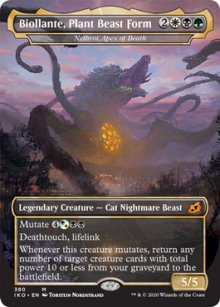
Nethroi, Apex of Death & Biollante, Plant Beast Form
& Biollante, Plant Beast Form
“Biollante first appears in the 1989 film Godzilla vs. Biollante. After Godzilla's return in 1984, Dr. Genshiro Shiragami attempts to use the monster's cells to genetically enhance various species of plants to create crops resistant to harsh weather. His attempts are initially thwarted when a bomb destroys his laboratory and kills his daughter Erika. Shiragami splices her DNA with that of a rose, which is nearly destroyed five years later by an earthquake. Hoping to make the rose immortal, he further splices its DNA with those of Godzilla, resulting in the creation of a hybrid mutant he christens Biollante. The creature roots itself into Lake Ashino, where it begins calling out to its progenitor Godzilla. Godzilla arrives and incinerates Biollante, whose spores float into the atmosphere. The spores later land near Osaka in the form of a much more Godzilla-like Biollante, who fights Godzilla to a standstill until the latter retreats after being weakened by the Anti-Nuclear Energy Bacteria. Biollante subsequently dissolves again and floats into space, with an image of Erika being seen among the spores.
The creature makes a brief cameo appearance in Godzilla vs. SpaceGodzilla, where it is speculated that its cells floating in space may have contributed to the creation of the monster SpaceGodzilla.” Wikipedia Link


Luminous Broodmoth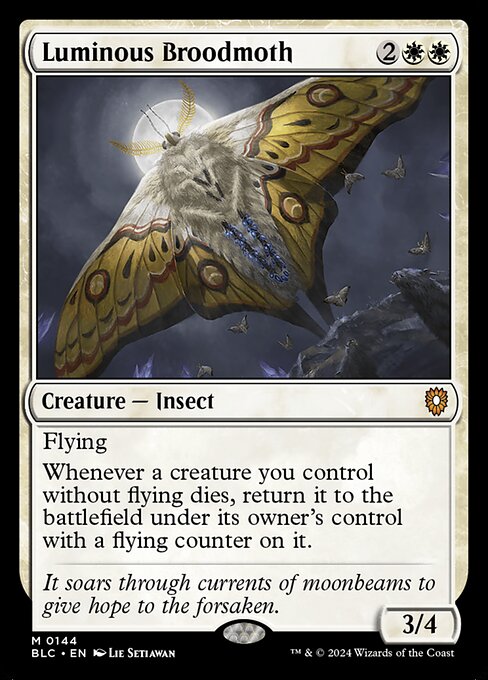 & Mothra, Supersonic Queen
& Mothra, Supersonic Queen
Mothra, “first appeared in the 1961 film Mothra, produced and distributed by Toho Studios. Mothra has appeared in several Toho tokusatsu films, most often as a recurring character in the Godzilla franchise. She is typically portrayed as a colossal sentient larva (caterpillar) or imago (moth), accompanied by two miniature female humanoids speaking on her behalf. Unlike other Toho monsters, Mothra is a largely heroic character, having been variously portrayed as a protector of her own island culture, the Earth and Japan. Though identified as a kind of moth, the character's design incorporates elements more frequently associated with butterflies, and has caddisfly-like mandibles rather than a proboscis. The character is often depicted hatching offspring (in some cases, twins) when approaching death, a nod to the Saṃsāra doctrine of numerous Indian religions.
Mothra is one of Toho’s most popular monsters and second only to Godzilla in her total number of film appearances. Polls taken during the early 1990s indicated that Mothra was particularly popular among women who were, at the time, the largest demographic among Japan's movie-going audience, a fact that prompted the filming of 1992's Godzilla vs. Mothra, which was the best-attended Toho film since King Kong vs. Godzilla. IGN listed Mothra as #3 on their ‘Top 10 Japanese Movie Monsters’ list, while Complex listed the character as #7 on its ‘The 15 Most Badass Kaiju Monsters of All Time’ list.” Wikipedia Link
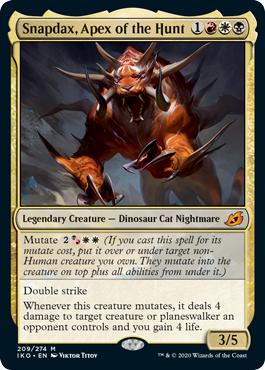
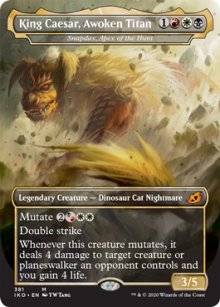
Snapdax, Apex of the Hunt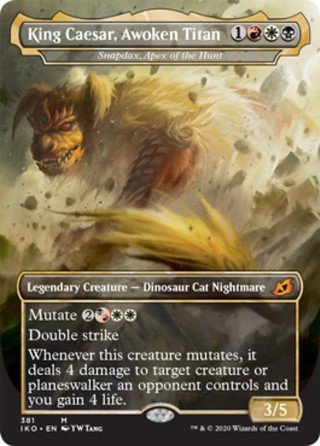 & King Caesar, Awoken Titan
& King Caesar, Awoken Titan
“King Caesar's character concept was inspired by a traditional Okinawan folk tale in which a Shisa protects a village from a rampaging dragon. This myth is referenced in the character's introductory film, Godzilla vs. Mechagodzilla, in which the titular Mechagodzilla plays the role of the evil "dragon". It is portrayed as a loyal and powerful protector of mankind, in reference to the role Shisa play in Okinawan tradition. Character profiles in supporting media describe the monster as standing 50 meters (164 feet)-100 meters (328 feet) tall and weighing 30,000 tonnes (33,069 short tons)-50,000 tonnes (55,115 short tons). King Caesar is shown to be swift and athletic. It can also draw an enemy's energy weapons into its right eye and reflect them back from its left eye with ten times the force, and empower itself with solar energy.” Wikipedia Link
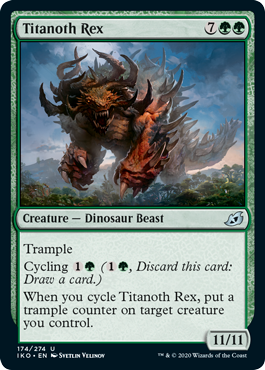
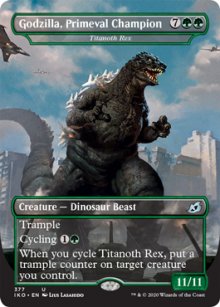
Titanoth Rex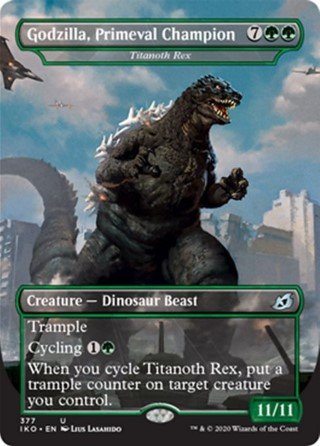 & Godzilla, Primeval Champion
& Godzilla, Primeval Champion
“Godzilla's origins are not always specifically explored in every continuity, but he has always been a type of prehistoric creature that was awakened by nuclear testing in the 1950s. In the Showa series and most of the Millennium series, Godzilla was a type of intermediary animal between sea and land-dwelling prehistoric reptiles that retreated deep underwater after the Cretaceous extinction and was awakened, burned, and enhanced by American hydrogen bomb testing. In the Heisei series, Godzilla was a type of dinosaur called a Godzillasaurus that survived into the 1940s living in the Marshall Islands. Time travelers from the future moved the Godzillasaurus to the Bering Sea, only for it to be exposed to radiation from a Russian submarine and become Godzilla sometime presumably in the 1970s. In GMK, Godzilla is a prehistoric animal that is possessed by the lost souls of people who died during World War II to punish Japan for its sins. In the MonsterVerse series, Godzilla is a type of giant prehistoric amphibious reptile from the Permian period that fed on radiation on the Earth's surface and retreated deep underwater following the Permian extinction. Godzilla was then awakened by an American nuclear submarine in 1954.” Monster Fandom Link

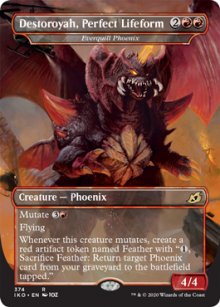
Everquill Phoenix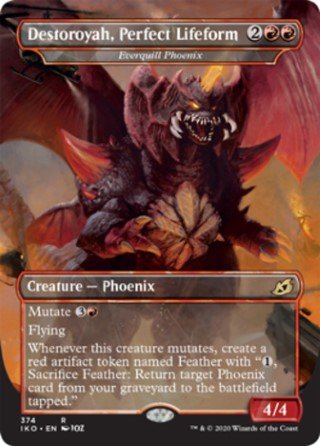 & Destoroyah, Perfect Lifeform
& Destoroyah, Perfect Lifeform
“Destoroyah was originally a colony of microscopic crustaceans from the Precambrian era that thrived in low-oxygen environments. The colony survived under Tokyo Bay for eons and was directly exposed to the Oxygen Destroyer in 1954 when it was detonated to kill the original Godzilla. The crustaceans were mutated by the Oxygen Destroyer and evolved abnormally over the next four decades. When a substance similar to the Oxygen Destroyer known as micro-oxygen was invented by Japanese scientist Dr. Ijiun, the crustaceans emerged from the bay and began combining with each other into larger and more powerful forms.” Monster Fandom Link

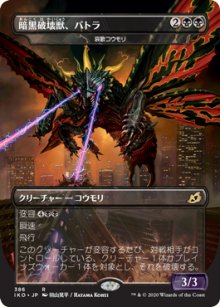
Dirge Bat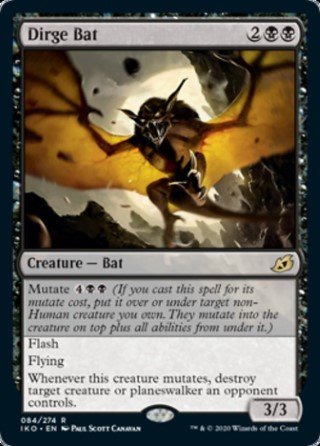 & Battra, the Destruction Beast
& Battra, the Destruction Beast
“Created twelve thousand years ago by the very Earth itself to combat a prehistoric civilization which had developed a weather control device, Battra was originally intended to simply destroy the device. However, the kaiju went too far and wiped out the entire race before turning its attention to humankind. In response Mothra, one of humanity's greatest protectors, did battle with Battra and bested it, eventually sealing it away deep beneath the North Sea.
In the modern era, Battra was awakened by a meteorite strike and quickly burrowed its way to Japan where it devastated one of the country’s major cities.
Later coming across a battling Godzilla and Mothra, Battra attacked Godzilla and the two sunk to the bottom of the Philippine Trench. Surviving the encounter, Battra emerged from the ocean depths, metamorphosed into its moth form, and sought out its old foe Mothra.
During its battle against Mothra, Godzilla reappeared and attacked Mothra, nearly killing the butterfly kaiju. Seeing this, Battra decided that Godzilla was the greater of two evils and assisted its former enemy. Together, Battra and Mothra defeated Godzilla, and carried his unconscious form out to sea. Godzilla was not done, however, and on the journey awoke and killed Battra by tearing out its throat and then blasting it with his signature atomic breath.” Monster Fandom Link


Gemrazer & Anguirus, Armored Killer
& Anguirus, Armored Killer
“Initially, Anguirus was an adversary of Godzilla, and the two fought before Godzilla gained the upper hand with a bite to the neck before ending the fight through the use of his signature atomic breath.
In Anguirus’ next appearance however, he is shown living peacefully on the island of Monsterland with Godzilla, before aiding the other in his battles against Gigan, King Ghidorah, Megalon and Mechagodzilla, although the latter Kaiju actually broke Anguirus’ jaw in the battle.
After an absence of thirty years, Anguirus reappeared, but this time as a puppet of the alien Xiliens who use the monster to attack Earth. Once again, he is ultimately defeated by Godzilla, but in recognition of their past friendship, Godzilla refrains from killing him.” Monster Fandom Link

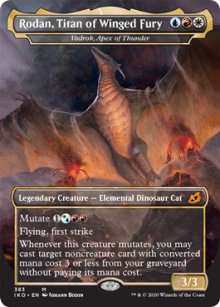
Vadrok, Apex of Thunder & Rodan, Titan of Winged Fury
& Rodan, Titan of Winged Fury
“Rodan is the name given to a number of different monsters which appear in Toho Company’s Godzilla franchise.
Enormous pteranodons mutated by a high dose of radiation, the Rodans usually walk bipedally when not airborne. Some incarnations boast a spiked chest and belly, whilst in others this is replaced by plates of a hard, bone-like material, and all sport small horns protruding from their heads. The various versions have been presented as being between 50 and 100 metres tall, possessing a wingspan of 220 to 200 metres, and weighing between 15,000 and 24,000 tons.
First encountered when a mining operation near an active volcano disturbed two Rodan eggs which promptly awakened, one of the Rodans proceeding to roam the countrysides of China, the Philippines and Japan before the Japanese Air Force launched fighter jets to intercept the threat. In the ensuing battle the Rodan was badly hurt, though not before razing a large portion of the city of Fukuoka to the ground. The second Rodan promptly showed up to escort its injured companion back to their nest where the pair prepared to hibernate, but the humans had other ideas. Dropping explosives into the volcano’s caldera to precipitate an explosion, one of the Rodans was caught and killed in the eruption, whilst the other was burned to death whilst attempting to save its friend.” Monster Fandom Link


Crystalline Giant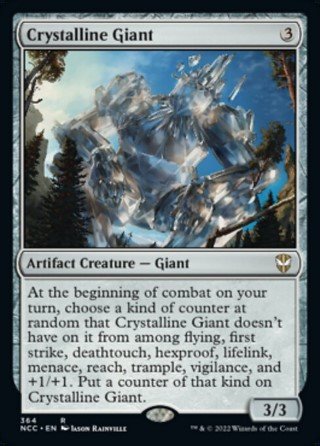 & Mechagodzilla, Decisive Battle
& Mechagodzilla, Decisive Battle
“First appeared in Jun Fukuda's 1974 kaiju film Godzilla vs. Mechagodzilla, the 14th film in Toho's Godzilla franchise. In its debut appearance, Mechagodzilla is depicted as an extraterrestrial villain that confronts Godzilla. In subsequent iterations, Mechagodzilla is usually depicted as a man-made weapon designed to defend Japan from Godzilla. In all incarnations, the character is portrayed as a robotic doppelgänger with a vast array of weaponry, and along with King Ghidorah, is commonly considered to be an archenemy of Godzilla.” Wikipedia Link
![]()

Sprite Dragon![]() & Dorat, the Perfect Pet
& Dorat, the Perfect Pet
“In Godzilla vs. King Ghidorah (1991), the creature is re-envisioned as a trio of diminutive genetically engineered creatures called ‘Dorats’ owned by a group of humans from the 23rd century known as the Equal Environment Earth Union, a group dedicated to equalizing the power of Earth's nations. Seeking to stop Japan's global economic dominance in their timeline by transforming the Dorats into King Ghidorah through nuclear exposure, the Earth Unionists plant the Dorats on Lagos Island during the 1954 H-bomb tests there. Prior to doing so, they remove the dinosaur that would ultimately become Godzilla from the island, so that King Ghidorah would be able to attack Japan without opposition. In 1992, the Earth Unionists unleash Ghidorah onto Japan, but he is defeated by a recreated Godzilla. The wounded King Ghidorah lies dormant under the sea for two centuries before being outfitted with robotic parts by a defected Earth Unionist and sent back to 1992 as Mecha-King Ghidorah in order to stop Godzilla's rampage.” Wikipedia Link


Pollywog Symbiote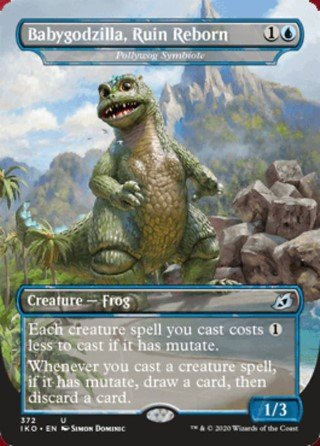 & Babygodzilla, Ruin Reborn
& Babygodzilla, Ruin Reborn
“Junior, also known as Baby Godzilla, Chibi Godzilla, and Little Godzilla is a young Godzillasaurus kaiju created by Toho that first appeared in the 1993 Godzilla film, Godzilla vs. Mechagodzilla II.
Godzilla Junior has a different name in each of his film appearances, each of which is individually trademarked. In Godzilla vs. Mechagodzilla II, he is called ‘Baby Godzilla’. In Godzilla vs. SpaceGodzilla, he is referred to as ‘Chibi Godzilla’, however Toho's preferred name for this version of Junior is actually ‘Little Godzilla’.” Monster Fandom Link

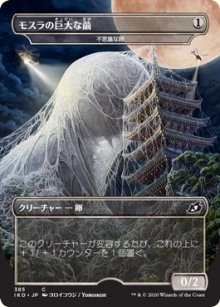
Mysterious Egg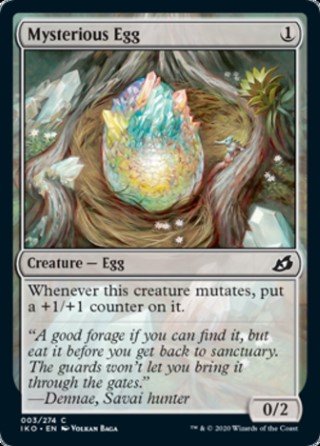 & Mothra’s Giant Cocoon
& Mothra’s Giant Cocoon
“Mothra hatched from her egg on Infant Island when the greedy Rolisican entrepreneur Clark Nelson kidnapped the Shobijin and brought them to Tokyo. Mothra swam to Tokyo and slithered through the city, causing mass destruction. The Japanese Self-Defense Forces used advanced heat ray tanks against Mothra, forcing her to build a giant cocoon on the Tokyo Tower. Mothra hatched from the cocoon in her imago form and flew to New Kirk City in Rolisica, where Nelson had escaped with the Shobijin. Nelson was shot and killed by police, and the Shobijin were freed. A group of humans drew Mothra's sacred symbol on an airfield, where she landed to recover the Shobijin. Mothra and the Shobijin then returned to Infant Island to live in peace.” Monster Fandom Link
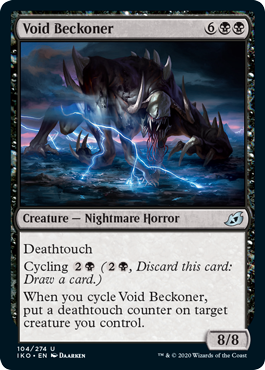

Void Beckoner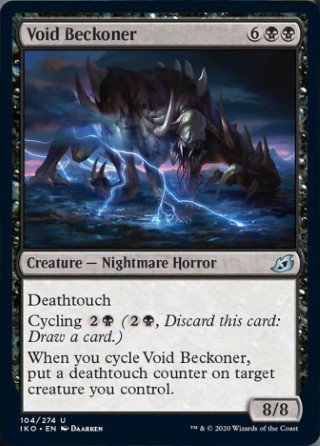 & Spacegodzilla, Void Invader
& Spacegodzilla, Void Invader
“SpaceGodzilla is a modified clone of Godzilla featured in the VS Series of Godzilla films. In Godzilla vs. SpaceGodzilla (1994), the film which introduced the creature, characters hypothesize that Godzilla cells somehow cast into space fell into a black hole and reemerged, mutated into a partially crystalline life form, from a white hole. As to how his cells had entered space in the first place, the film offers two possibilities: either cells from Godzilla's previous clone Biollante escaped Earth orbit after the kaiju did battle (Godzilla vs. Biollante, 1989) or Mothra inadvertently carried the cells into space en route to deflecting a meteor headed for Earth (Godzilla vs. Mothra, 1992).” Aliens Fandom Link
SpaceGodzilla can fire a Corona Beam from his mouth that he can control midair, has a super regenerative power, has two shoulder crystals that can generate a Gravity Tornado that can lift other objects or himself, can fly by means of enclosing himself in crystals, increases in power by being near gigantic crystals that he creates, can conduct energy through his touch, is able to implant cosmic power in structures that can transmit a signal and have them act as an energy source, can encase his body in a shield to deflect projectiles, is able to unleash bolts of energy from his shoulder crystals, and emits an aura that causes electrical disturbances. Id.
Secret Lair Godzilla Lands (more information here):

Here's a link to an Aetherhub decklist with 1x of every Godzilla Monster Universe card in Ikoria.
About CaptainJamoke:
CaptainJamoke's Streamlabs "Website"
Full time job: Attorney (No legal advice)
Location: North East, United States




Godzilla in MTG - Was ist only a matter of time?!? ;)